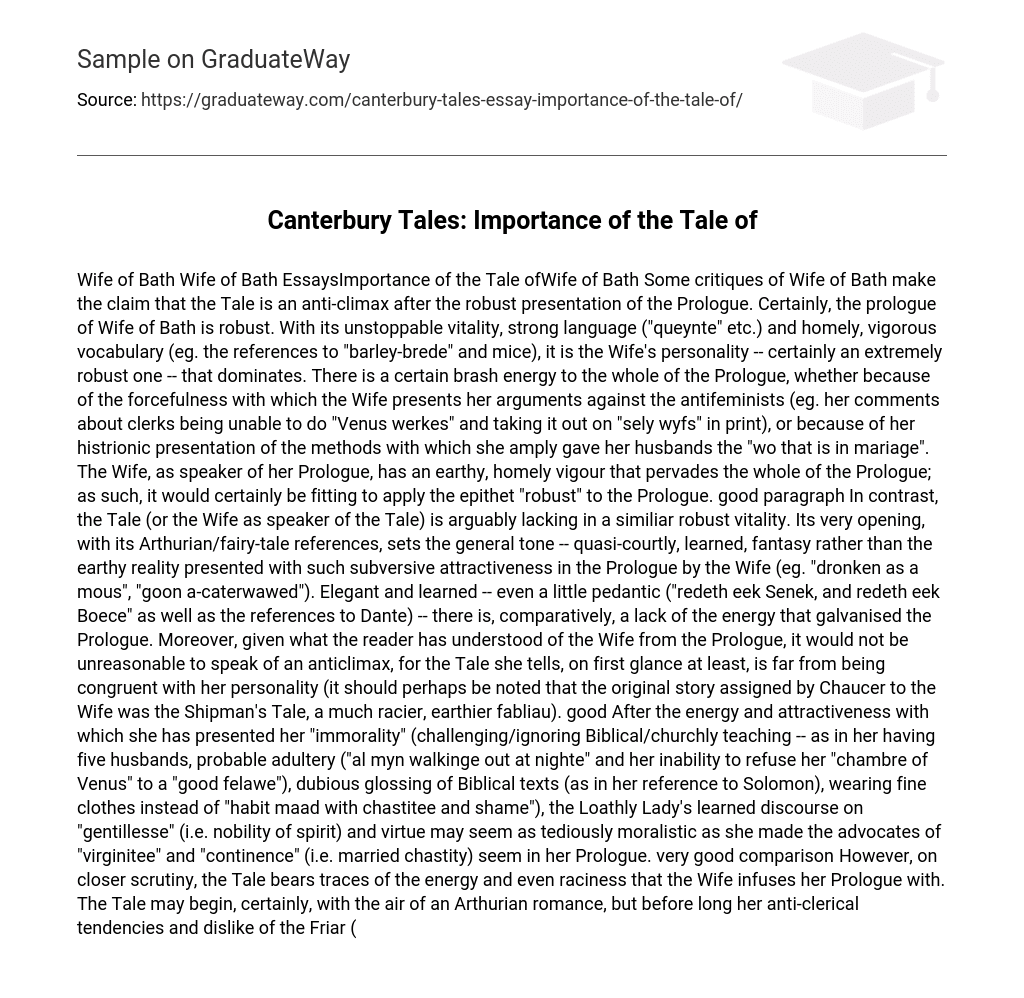Wife of Bath Wife of Bath EssaysImportance of the Tale ofWife of Bath Some critiques of Wife of Bath make the claim that the Tale is an anti-climax after the robust presentation of the Prologue. Certainly, the prologue of Wife of Bath is robust. With its unstoppable vitality, strong language (“queynte” etc.) and homely, vigorous vocabulary (eg. the references to “barley-brede” and mice), it is the Wife’s personality — certainly an extremely robust one — that dominates.
There is a certain brash energy to the whole of the Prologue, whether because of the forcefulness with which the Wife presents her arguments against the antifeminists (eg. her comments about clerks being unable to do “Venus werkes” and taking it out on “sely wyfs” in print), or because of her histrionic presentation of the methods with which she amply gave her husbands the “wo that is in mariage”. The Wife, as speaker of her Prologue, has an earthy, homely vigour that pervades the whole of the Prologue; as such, it would certainly be fitting to apply the epithet “robust” to the Prologue. good paragraph In contrast, the Tale (or the Wife as speaker of the Tale) is arguably lacking in a similiar robust vitality. Its very opening, with its Arthurian/fairy-tale references, sets the general tone — quasi-courtly, learned, fantasy rather than the earthy reality presented with such subversive attractiveness in the Prologue by the Wife (eg.
“dronken as a mous”, “goon a-caterwawed”). Elegant and learned — even a little pedantic (“redeth eek Senek, and redeth eek Boece” as well as the references to Dante) — there is, comparatively, a lack of the energy that galvanised the Prologue. Moreover, given what the reader has understood of the Wife from the Prologue, it would not be unreasonable to speak of an anticlimax, for the Tale she tells, on first glance at least, is far from being congruent with her personality (it should perhaps be noted that the original story assigned by Chaucer to the Wife was the Shipman’s Tale, a much racier, earthier fabliau). good After the energy and attractiveness with which she has presented her “immorality” (challenging/ignoring Biblical/churchly teaching — as in her having five husbands, probable adultery (“al myn walkinge out at nighte” and her inability to refuse her “chambre of Venus” to a “good felawe”), dubious glossing of Biblical texts (as in her reference to Solomon), wearing fine clothes instead of “habit maad with chastitee and shame”), the Loathly Lady’s learned discourse on “gentillesse” (i.e.
nobility of spirit) and virtue may seem as tediously moralistic as she made the advocates of “virginitee” and “continence” (i.e. married chastity) seem in her Prologue. very good comparison However, on closer scrutiny, the Tale bears traces of the energy and even raciness that the Wife infuses her Prologue with. The Tale may begin, certainly, with the air of an Arthurian romance, but before long her anti-clerical tendencies and dislike of the Friar (who previously interrupted her) prompts a cheeky poke at the latter, with its references to the “limitours” who act as “incubii” i.e. engaging in carnal relations. The Tale is also not without some homely touches — cf.
the alliterative energy of “as a bittern bombleth in the mire” — and if the curtain-lecture on “gentillesse” and poverty is uncharacteristic and even somewhat effete in contrast to the celebration of the flesh and the world to be found in the Prologue, there is, on the other hand, the (edited) story of Midas, with its brazen acknowledgement of anti-feminist accusations, the emphasis on women’s love of “maistrie” (even more than “richesse” or “lust abedde”), and the emphasis on the sovereignty of women (the knight’s case is transferred to a jurisdiction presided over by ladies, and it is also a woman who tells him the answer.) And whenever these topics arise, the vigour of the Prologue returns (cf. the emphasis — again alliterative — of “to be often widwe, and wedded”). Above all, there is the ending to be reckoned with — if the fairy-tale ending (and a rather predictable one, too) is an anticlimax, there is then the sudden jolt to the reality of the Wife’s wanting “housbondes meeke, yonge, and fressh abedde” and her energetically humorous imprecations upon “olde and angry nigardes of dispense” recalling her Prologue (“maugree thine yen”, for example). As such, it would not be totally accurate to speak of the Tale as being an anticlimax.
While its seeming “gentillesse” may be found somewhat colorless after the Prologue, it nevertheless reinforces the Wife’s ideas of female “maistrie”, and certainly this is obvious by the end; also, the ending arguably serves as a climax, summarizing many of the Wife’s themes (that women should have the “maistrie”, that she wants a constant supply of young virile husbands, that marriage can be happy if a husband first resigns authority to his wife (cf. her ending the Prologue with the kindness she showed to Jankin and their ostensible happiness)). Therefore, even if the Tale does not work up inexorably to a climax as the Prologue per se does, it would be unfair to claim that it has no climax, or that it is an anticlimax.





